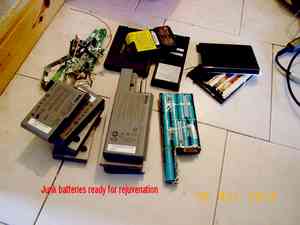
| Due to growing number of portable computer users it becomes very easy to get junk batteries for free. As soon as the battery is not able to power the pc during a decent time ,sooner or later its owner will throw it away .Based on my little experience obtained recently on 23 batteries recovered from various sources it appears that only 1 was completly dead .The others can be put back at work to power either another portable computer or a vhf/uhf transceiver as we will show here after |  |
| BATTERY PACK DESCRIPTION The technology evolved a lot since the stone age of portable computing .At the begining battery for portable Pc was straight nickel/cadmium .Later NICKEL METAL HYDRID arrived giving more energy for the same weight .Next wasLithium ion battery giving even more power . The nominal voltage of each element of this type is in the range of 3.6 volt .To reach the desired voltage it is needed to put several elements in serie(generally 3 to 4 ).Each element have standarzided size . |
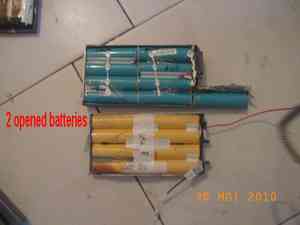 |
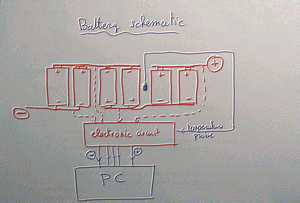 |
To prevent any problem during charge or discharge a more or less complex circuitry monitor the battery controlling the current the voltage and the temperature and giving informations to the computer |
| BATTERY DIAGNOSTIC The first thing is to find out the output ,where is the + and - terminals .This is easyly done if the battery is not completly discharged with a voltmeter .If is not possible to find any significant voltage between two terminals you will have to open the battery with a cutter . 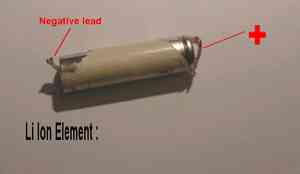 While open it becomes very simple to find out where the battery terminals are . As you will notice a battery is an assembly of standard elements linked together both in serie and in parralel in order to achieve the desired voltage (in volts) and thedesign capacity (in mA.h) .The first thing will be to measure the voltage of each group in serie .Assuming that all voltages are more or less equal in the range anywhere between 0.2 and 4 volts you are lucky the battery can be simply recovered by charging it (as it will be showed after) . Very often (in 4 cases out of 23 in my case) one element group is completly dead and the others are almost as good as brand new ones .In this case you will have to remove it from the assembly .Next you can either completly dismantled the battery to recover the good elements or replace the faulty group by a good one taken in another battery .Of course there is good chances that the capacity of each element are below the design capacity .To measure the capacity there is several setup over the internet showing how to do it : for example take a look at this one (a set up to measure capacity).You are not oblige to use such a fancy set up .Another one consist of discharging the fully charged battery through a known resitor to get the amperage you need in the future for this battery .A convenient way of doing is to use electric light bulbs used for cars (you have various grades to match your needs ) to load the battery for discharge.An easier way is to power the laptop computer running a small programm writing on the hard disk drive every 5 minutes a time stamp .When the battery is completely exhausted the lap top is not longer writing anything , and by looking at the last record you can know how long it was powered .Ok this is not a very smart way of doing but it works . |
|
| REASSEMBLING THE BATTERY The first thing is to put in the case element in good shape .After you remove the electronic circuitry .Depending of the voltage needed you put 3 or 4 element in serie, the number of elements in paralel being the same If youwant to power a portable PC through the charging terminal you will have toknow the voltage accepted wich is generally written on the back pf the PC ,the same thing if you want to power your transceiver.For example to get 10 volts you will need 3 elements in serie |
|
| CHARGE/DISCHARGE CONTROL The simplest thing is to monitor the total voltage across the battery .The schematic is simple , a micro amp meter (full scale 500 micro amp ) in serie with a zener diode and a resistor will do the job (refer to the schematic) .The zener diode should have a value around 8 volts , the resistor in serie depending on the sensibility of the meter in order to get full scale when the battery is fully charged . For charging one easy way consist of charging with constant current(1/4 of capacity e.g 0.5 amp for a 2 amp.h battery ) during 3 hours .If you don't have regulated power supply you can find on the net or even in any department store .Prefer to take one with adjustable voltage between 5 up to 18 volts .Other ways of doing for charging are also possible in all case you have to check that no overheating is occuring during the charging process .As a rule when the battery begins to have a temperature 5 degree C above ambiant temperature this means that the battery is completely charge and almost all the energy injected is truned into heat and not recharging the battery .You can also add a fuse in serie to limit the max current .If you start from a completely unloaded battery you will have to limit the current during the first minutes of charging to limit the current below 1.5 amp .Dont be afraid of the explosion risk .Based on recent statistic the risk to be killed by the explosion of an overcharged battery is far below the risk of being put to death by a car while crossing a street in an urban area |
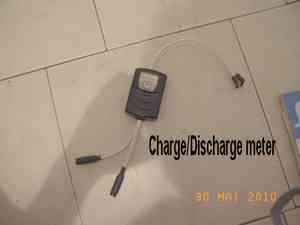 |
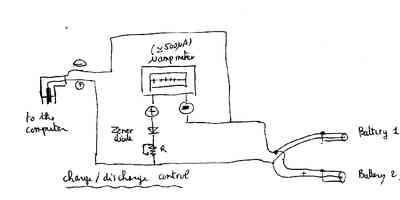 |
If you plan to use the battery to power a laptop
computer .It is a good idea to add a double
input to be able to power it with 2 packs adding or removing one
without interuption of power for the computer .When using the battery
the voltage remaining in the battery will be readable on the meter and
when it will reach the low level mark you will have to put in service a
full charged battery or shut down the computer .I |
If you do not have a meter of the suitable size or sensitivity you can also monitor the charge/discharge using a dedicated circuit like LM3914 (costing around 2 US $ ).This one use 10 diodes to show the voltage anywhere between 2 values that you can select with 2 adjustable resistors .The set up is not complicated , cost less than the previous one but will take more time to be operationnal than the meter version .Its consumption will be also a little higher (around 10 ma ) compared to the meter version which consumes less than 1 ma of current . |
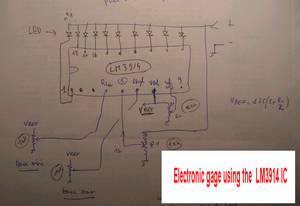 |
It is also
possible to monitor the charge/discharge of your reconditionned Li-ion
battery using a very simple design based on silicon diode/zener diode
and LED (the LED LADDER ).The 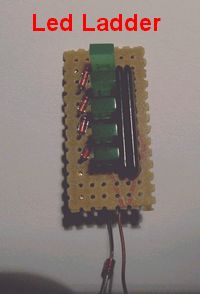 schematic
is outlined herealong Depending on the voltage more
or less LED are lighted .The minimum voltage is fixed by the zener
diode ..With 5 LED and 4 silicon diodes you cover a voltage range
of 3
volts which represent more or less the voltage variation of a 10 .5
volt Li Ion batteyr during its useful discharge .The consumption is
low and depend on the type of LEd you use (around 1 mA).If you
want to cover a larger range you add more silicon diode in series
.This is by far the cheapest design for your electonic gage . schematic
is outlined herealong Depending on the voltage more
or less LED are lighted .The minimum voltage is fixed by the zener
diode ..With 5 LED and 4 silicon diodes you cover a voltage range
of 3
volts which represent more or less the voltage variation of a 10 .5
volt Li Ion batteyr during its useful discharge .The consumption is
low and depend on the type of LEd you use (around 1 mA).If you
want to cover a larger range you add more silicon diode in series
.This is by far the cheapest design for your electonic gage . |
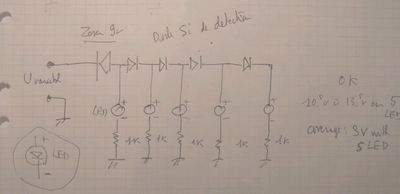 |
The discharge voltage of a Li-Ion battery is far to be constant during its useful service , this is not a problem for the switching power supply of the computer which is using the battery (when the voltage is going down it takes more Amp to compensate till a given extend ) but this can be a different story when using it to power you transceiver as they are not as tolerant (generally the output power decrease ) .As an example a battery with a rated voltage of 10.8 volt see its output varying from 12.0 volt at the begining going down to 9 volt at the end as shown on the curve on the left showing a CHARGE/DISCHARGE/CHARGE cycle . |
Bigger Display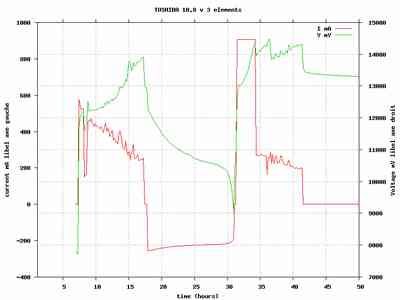 |
|
POWERING PHONE You can also use recovered Li Ion element to power your phone .In this case the simpler way is to used the battery pack as a substitude to the wall charger .The number of elements to use will depend on the nominal voltage used to recharge the built in battery of the phone .Very often this battery is one element Li Ion and require 5 volt to be charge .In this case you will make a battery pack of 2 elements in serie giving you a voltage in the 7 volt range not to high for the switching power regulator of your phone .This battery pack will allow you to double or triple the phone duration as the element recoverd from junk lap top battery have a much higher capacity than the phone tiny built in battery |
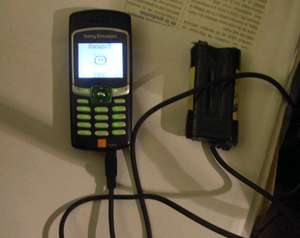 |
Powering electric torch Electric torch rely mostly on non rechergeable battery .Recovered Li Ion battery can be used in place the capacity being 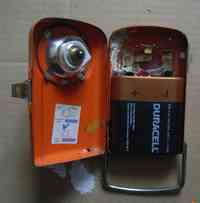 generally
much greater than with the original power supply .A case very
interested is for electric torch using 4.5 volt battery .Surprisingly
this type of battery have almost the same size as Li Ion battery and
therefore the change is very simple to be made .DUe to the better
conductivity of Li Ion you do not need to stack up many elements to
reach the same voltage .For example to have the same efficiency as a
regular 4.5 batery you only need to put one element Li Ion battery
.Needless to say that if you want to increase the capactiy you can put
as many elements needed in parallel (up to 3 in the case of standard 4.5 volt
electric torch generally
much greater than with the original power supply .A case very
interested is for electric torch using 4.5 volt battery .Surprisingly
this type of battery have almost the same size as Li Ion battery and
therefore the change is very simple to be made .DUe to the better
conductivity of Li Ion you do not need to stack up many elements to
reach the same voltage .For example to have the same efficiency as a
regular 4.5 batery you only need to put one element Li Ion battery
.Needless to say that if you want to increase the capactiy you can put
as many elements needed in parallel (up to 3 in the case of standard 4.5 volt
electric torch |
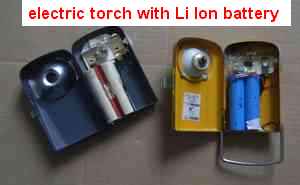 |
| ADJUSTING VOLTAGE TO YOUR NEED Very often the voltage you need is not equal to the one given by the battery pack .It can be higher or lower .In both cases you are not blocked .There is cheap IC which are able to make the conversion with a very good efficiency (> 90%).For example you want to get a 5 volt regulated power supply from your battery pack giving a 10.5 volt .You have a huge choice of IC being able to do the job .Let assumed you choose the MAX638 IC as shown herewith , with only 3 capacitors ,1 diode and 1 inductor you will get a 5 volt regulated supply giving up to 100mA. There is various other circuit according to the voltage and power needed . |
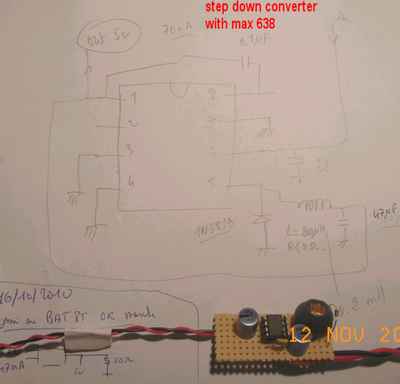 |